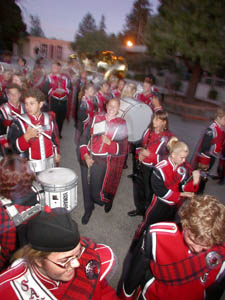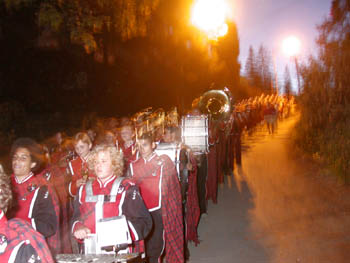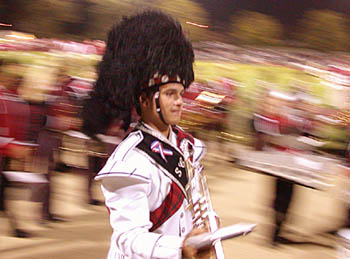![[Metroactive Music]](/music/gifs/music468.gif)
[ Music Index | Santa Cruz Week | SantaCruz Home | Archives ]
Photograph by Stephen Laufer
Three Minute Warning
They've been ridiculed, written off and forced to endure endless referencing of 'American Pie.' But this weekend in Santa Cruz, dozens of high-school marching bands strike back.
By Rob Pratt
ALBERT EINSTEIN didn't think much of marching. "That a man can take pleasure in marching in formation to the strains of a band is enough to make me despise him," he wrote. "He has only been given his big brain by mistake; a backbone was all he needed."
In Hollywood, marching bands and those who play in them fare little better--they're the nerdiest of all nerds. For proof, check Revenge of the Nerds or any other movie that lays out the high-school food chain. And if you really want to get punched in the face, maybe you could be the 84 millionth person to say, "Oh, you're in band? Remember that part in American Pie where the chick is like, 'This one time, at band camp?'"
All things considered, it's no wonder that one of the most enduring traditions of high school is making fun of the school band. But the truth is that when the drum major whistles the roll-off and everyone in the band, the color guard and the other marching teams puts their left foot forward, those ridiculed band members show off more coordination and training than a football team sprinting into the end zone for a last-minute clincher. Forty kids at a minimum (some high school marching bands number in the hundreds) must stay in tune, stay in step and stay completely focused on musicality and showmanship. When it all comes together, the result can make even the most cynical observer inwardly beam with a curious, unself-conscious pride.
On Saturday, nearly four dozen middle and high school marching bands take to the streets of downtown Santa Cruz for one of the longest-running marching band reviews in Northern California. They form up on the Santa Cruz High School football field, a cacophony of drums, brass and reeds. At appointed times beginning at 9am, they line up on Myrtle Street and march down Maple Street for one final chance to practice their routine on Washington Street. Eventually, inevitably, they must quietly make their way to the competition line on Laurel Street, where they can silently contemplate their three minutes in the spotlight. That's right, three minutes to showcase dozens of hours of hard work.
So, why even bother? It's the glory, man, the glory.
"I used to tell my students that before you get to that line, you're only 65-or-so inches high," explains Silvester McElroy, who led the Santa Cruz High School marching band between 1962 and 1989, and who organized the first Santa Cruz Band Review 27 years ago. "But when you step off in competition, you're 9 feet tall, and there's nobody who can touch you."
Pride Goeth Before a Call
On a warm fall morning in rural Watsonville, music director Tom Bruce barks at 45 young instrumentalists. In a 10-minute crush between classes, the Monte Vista Christian High School marching band has filed into the band room (a spacious loft above the gym that once held the weight room), unpacked instruments, filed downstairs and assembled behind the gym for a semiweekly marching drill. The players line up in row-and-file order, enduring taunts from physical education students wandering out of locker rooms and headed for the athletic fields.
"Band! A-ten-shun!" Bruce yells. "Band! Dress right, dress!"
He leads them through a dozen commands, snapping his fingers in time. All marching band commands and maneuvers happen on beats. Four beats to attention. Eight beats to begin marching. Four beats between rows as the band marches by. Eight beats to stop.
"Where does respect come from?" he says.
"Pride!" the band members holler back.
"Where does pride come from?" he says.
"Work!" they reply.
The last exchange earns sniggers from the nearby PE students, but by now the band members pay little attention. Eyes are forward, instruments held six inches out front. When Bruce whistles the forward-march command--"Deeoo-weet! Deet! Deet! Deet! Deet!"--the group marches down a winding asphalt path from the gym to the main football field half a mile away. Bruce coaches on marching technique during the trip to the field. Watch your spacing, he says. Glide step. Roll from heel to toe. Lean back.
The band marches down to the far end of the field, drum section snapping out a cadence the whole way, then onto the grass and out to midfield. Bruce directs the band through "The Star-Spangled Banner" and then commands, "Horns down."
"That was good," he says. "Now's your chance to show me that you're smart and not just trainable. We're going to do it again, but this time you're going to exit to the right."
March, Baby, March: Marching teams have just three minutes to strut their stuff in competition.
Work for It
Getting a marching band ready for performance takes an incredible amount of work, McElroy explains. According to his estimate, which he has refined during 30 years of directing high school marching bands, one minute of marching performance requires 10 hours of preparation.
Using that formula, the three-or-so minutes of performance involved in a band review requires upwards of 30 hours of work. Since most high schools start their academic year four weeks before the first band review of the autumn season, and since most high school bands only get one hour of rehearsal during school hours per day, any marching band that wants to win trophies has to put in a lot of time after school.
When her daughter announced that she wanted to join the color guard at Santa Cruz High, Susan Shane, co-president of the Cardinal Regiment's band boosters, had no idea that the group would require such a high level of commitment.
"It surprised me how much work the kids put into it," she says. "I was also surprised how athletic the kids have to be. I don't think you can really understand until you're marching on the street, trying to play your horn and trying to know your left foot from your right foot."
Gabe Ramos works hours and hours every week to keep up with his marching band responsibilities. A junior at Santa Cruz High School, the 17-year-old Ramos is in his second year as drum major of the Cardinal Regiment, and he's responsible for organizing the band for rehearsals, drilling members on marching maneuvers and, most importantly, cueing the roll-off that takes the band into competition. Last year, his first year leading the band as drum major, he earned first place in his drum major division at the Northern California Tournament of Champions, an end-of-season marching contest for the best high school marching bands in the region.
"The other day I spent two hours just doing this," he says. Ramos twirls his mace, a long, heavy staff traditionally carried by marching band drum majors. "I just stood there like this"--at attention, twirling his mace clockwise--"and people at school kept asking me what I was doing and trying to make me lose my concentration, but I kept spinning because I want to be as good with my left hand as my right hand. Actually, I want to be better with my left hand than with my right hand."
Right now, Ramos is working on his flourish, a 15-second-long salute delivered to judges or other dignitaries before he signals the marching band to step off and begin playing. He spins the mace in front and in back of his head, tosses it twice, bows his head in slow motion, snaps to attention and steps off in a stylized strut.
"A lot of drum majors do a toss," he says. "But they don't throw it as high. I figured out that I can put my hat forward and look up more and people won't notice that I'm not looking forward."
Marching Into History
Marching bands have a mystique, an otherworldly quality that perhaps comes from the unique times when marching bands have traditionally performed. For parades, they glide by in a grand performance of three minutes at most, approaching with a drum cadence and a flourish of color, then receding with a diminuendo as the unit moves down the street. For ceremonial functions, they take to the bandstand on days that stand out of time--the Fourth of July, presidential inaugurations or days of national celebration or mourning.
The first historical reference to an American marching band dates to 1633, when drummers accompanied a marching practice organized by the compulsory militia of the Colony of Virgina. By 1756, the tradition was well established, and today the fife-and-drum corps at Fort Ticonderoga is an enduring image of the Revolutionary War.
An act of Congress in 1798 made the United States Marine Band the official band of the republic, charging the unit with accompanying the president in state ceremonies. However, a distinctly American-style marching band didn't develop for another 80 years, until orchestral violinist and conductor John Philip Sousa took over the Marine Band in 1880.
As bandmaster for the next 12 years, Sousa rocketed the band to world-class status and penned original music in a bright, rhythmic style that has since become synonymous with the American marching band tradition.
Sousa's most popular work during his lifetime, "The Washington Post," debuted in 1889 and instantly became a sensation--the 19th-century equivalent of Michael Jackson's Thriller album. But today it pales in comparison to the mythic legacy of "The Stars and Stripes Forever," which Sousa wrote in 1897. It was like a best-of Sousa compilation packed into a single song, and in the 100 years since then it has eclipsed all others to become his musical legacy. The brisk tempo; the optimistic, major-key tonality,; the rhythmically complex themes; and, of course, the thundering "break-strain" before a piccolo-trombone counterpoint finale--the damn thing is just astounding in the way it combines everything that was good about a Sousa march.
Meanwhile, the American marching band sound Sousa pioneered has descendants among many of the homegrown American musical styles prevalent today. New Orleans second-line funk evolved from marching bands that played for community celebrations into the jazz of Louis Armstrong and the electrified funk of the Meters. Turn-of-the-century ragtime music, a precursor of jazz, takes its form and harmonic sensibility from march music, specifically taking its cue from the major-key Sousa sound.
Musical Dynamics
Cristy Lapham, though, prefers the darker sound of the European march. For this year's marching band season, she has chosen "Arnheim" by German composer A.E. Kelly as the sound of Santa Cruz High School's Cardinal Regiment marching band. Lapham, now in her fourth year as band director, has zeroed in on the psychology of marching band competitions. She cajoles her students to play uncool instruments. The sousaphone--another of the Marine Band director's innovations--is a circular bass tuba with an over-the-top bell. The euphonium looks like a pint-sized tuba and plays in the range of the trombone. The mellophone is basically a French horn shaped like an oversized trumpet, but with a large, flared bell. None of them have appeared on a hit recording since the Great Depression.
Instrumentation is all-important, Lapham says. Of the four dozen students in the marching band, more than a quarter play low brass--sousaphone, euphonium, trombone or mellophone. The sound is big and forbidding, and on the minor-key tonality of "Arnheim," the Cardinal Regiment has a sound much larger than 50-odd instruments could produce if composed mostly of flutes, clarinets and alto saxophones.
Before the first note of the march, Lapham leads the band through an extensive warm-up as they form a circle north of the grandstand on the high school's football field. Sousaphones form up at the center, other low brass to the left, trumpets to the right and woodwinds stretching from low to high to the legs of the arch. The drums clump in the middle, playing a time-keeping cadence.
The musical warm-up starts with a choralelike exercise based on a dark harmonic minor scale. It's in the key of "Arnheim" and using the same harmonic-minor tonality, Lapham says. That's so that all of the players in the band get the sound of the march and the tuning of the chords stuck in their heads.
"OK, now we're going to play the march, and I want you to play as quiet as you can play," Lapham says.
This musical warm-up is the only time that Lapham directly leads the band. For almost everything else the band does during warm-up or performance, Lapham lets Ramos take charge. While the band plays "Arnheim" in a subdued mezzo-piano, Lapham calls out instructions. Ramos listens attentively at first, then moves away from the band to practice his mace twirls and flourishes.
"You should always play this part this quiet," Lapham yells to the band. "Listen to the trumpets--they have the melody."
At the end of the march, Lapham compliments the group on a focused and artful rendition of "Arnheim." Every instrument had exactly the right place in the overall blend of the music, she tells the band, because everyone listened intently.
The next time through the march, Lapham tells the band to play as loud as possible. The band starts off big and brassy, but soon the sound becomes shrill and unbalanced--all trumpets and piccolos and drums--as the players tire out from playing at full volume.
"You have to keep the same balance when your loud as when you're soft," Lapham yells. "Even when you're playing loud, you have to listen."
In Formation Overload: Gabe Ramos of Santa Cruz High is all hat.
A Culture of Commitment
"There are really only two places in high school that teach students good group discipline," McElroy says. "That's in the arts, like band, chorus and drama, and in athletics. In academics, if you goof off, that only affects you. But in band or athletics, it affects the whole group.
"One time a math teacher asked me why I always gave my students A's," he continues. "I told him that if he worked extra hours with his math students then took them down to football games and had them do math in front of 5,000 people every other week, then he'd see that they all deserve A's. If they go down there and put in all that work, then they deserve the good grades that they got."
Unfortunately, band is often one of the first school programs to go when budgets get lean. The golden age for the Santa Cruz High School Band came to an abrupt end, McElroy says, when the tax-cutting initiative Proposition 13 passed in 1978.
"That really hurt because the first thing they cut was music," he adds. "But thanks to the Packard Foundation recently, we got most of it back. I think you'll find a rise in the size of groups in the next few years."
Funding, though, isn't the only thing that can put a marching band at risk. Keeping students involved and motivated to do all the work of rehearsing, drilling and performing takes a culture of commitment.
Lapham says she has worked extremely hard to rebuild that culture of commitment, and has seen it start to take hold. During the 11 years between McElroy's retirement and the time Lapham took the baton at Santa Cruz High, the band program went through 10 different directors.
"It takes time to build up that tradition of commitment," Tom Bruce explains. "I had a parent ask me if her kid could still perform even though he can't come to rehearsals. I asked her, 'Will the coach let your son play in a baseball game if he doesn't go to practice?' It's going to take time for all the students and the parents to understand."
This year marks Bruce's third year as director of bands at Monte Vista Christian High School. A classically trained trumpeter, Bruce spent years working for national symphonies in Singapore and Germany before returning to the United States to start a family. Since taking the position at Monte Vista, he's spent summers at marching camps and school years teaching his students that marching band is a team that requires total involvement.
Like Lapham, Bruce thinks that all of the band's work is starting to show results. He's quick to say how proud he is of this year's group--how hard they work and how little they complain. During his first year, the band scored last in their division. Last year they won it.
This year, he says, the band is even better.
Copyright © Metro Publishing Inc. Maintained by Boulevards New Media.
![]()
 Sash Mill: Marchers take a break from all those crushingly straight lines during practice for the Santa Cruz Band Review.
Sash Mill: Marchers take a break from all those crushingly straight lines during practice for the Santa Cruz Band Review.

Photograph by Stephen Laufer

Photograph by Stephen Laufer
The Santa Cruz Band Review steps off on Center Street (between Washington Street and Laurel Street) at 9am Saturday.
From the October 16-23, 2002 issue of Metro Santa Cruz.